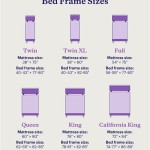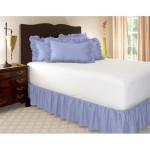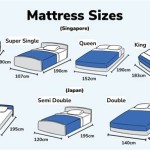What Are The Inches of a Full Size Bed?
A full-size bed, also known as a double bed, is a popular choice for individuals seeking a bed larger than a twin but smaller than a queen. Understanding the exact dimensions of a full-size bed is crucial when planning a bedroom layout, purchasing bedding, and determining whether the bed will comfortably accommodate the intended users. This article provides a comprehensive overview of the dimensions of a full-size bed, its advantages and disadvantages, and other factors to consider when choosing a bed size.
The standard dimensions of a full-size bed are 54 inches wide and 75 inches long. These dimensions represent the interior space available for the mattress and sleeping area. It is essential to note that these are standard sizes, and minor variations may exist depending on the manufacturer and the specific bed frame design.
When calculating the total space required for a full-size bed in a room, it's important to consider the dimensions of the bed frame in addition to the mattress size. Bed frames can add several inches to the overall width and length of the bed. Platform beds, for instance, often have a larger footprint than traditional frames with headboards and footboards. Measuring the full dimensions of the bed, including the frame, is necessary to ensure it fits comfortably in the designated space.
The height of a full-size bed can also vary significantly. The height depends on factors such as the type of bed frame, the thickness of the mattress, and whether a box spring is used. Some individuals prefer a lower bed, while others prefer a higher bed for ease of getting in and out. The standard height of a bed, including the mattress, typically ranges from 18 to 25 inches. However, this can be adjusted based on personal preference and physical needs.
Key Point 1: Standard Dimensions of a Full-Size Bed
The core measurement to remember when considering a full-size bed is its standard dimensions: 54 inches wide by 75 inches long. These dimensions provide a substantial sleeping surface for a single adult and can even accommodate two smaller adults or children in certain situations. While the length is the same as a twin bed, the significant increase in width offers a much more comfortable sleeping experience, particularly for those who tend to move around during the night. The 54-inch width provides ample room for stretching and prevents the feeling of being confined to a small space.
The standardized size of full beds also makes it convenient to find mattresses, bedding, and other accessories. Most retailers carry a wide variety of options specifically designed for full-size beds, ensuring compatibility and ease of purchase. This standardization simplifies the process of furnishing a bedroom and reduces the likelihood of compatibility issues.
While the standard dimensions are generally consistent across manufacturers, slight variations can occur. These variations are often minimal, usually within an inch or two, but it's always a good idea to double-check the exact measurements before making a purchase. Reading product specifications carefully and confirming measurements with the retailer can help avoid any unwanted surprises during installation.
The 54x75 inch dimensions of a full-size bed are a defining characteristic that differentiates it from other bed sizes. This size strikes a balance between spaciousness and space efficiency, making it a versatile option for various bedroom layouts and personal needs. The established standard simplifies the process of selecting appropriate bedding and ensures compatibility with most bed frames designed for full-size mattresses.
Key Point 2: Advantages and Disadvantages of a Full-Size Bed
Full-size beds offer several advantages that make them a popular choice for diverse needs. Their size provides a good balance between space and comfort. For single adults, a full-size bed offers ample room to stretch out and sleep comfortably. The extra width compared to a twin-size bed is particularly beneficial for those who tend to move around during sleep.
Full-size beds are also a viable option for guest rooms, as they can comfortably accommodate single guests without requiring the space of a larger queen or king-size bed. They are also suitable for children transitioning from a toddler bed to a larger bed, providing enough space for growth without overwhelming a smaller bedroom.
Another advantage of full-size beds is their affordability. They generally cost less than queen or king-size beds, making them a budget-friendly option for individuals or families looking to furnish a bedroom without breaking the bank. The lower price extends to mattresses, bedding, and other accessories, resulting in overall cost savings. Given the economic considerations for space and budget, a full sized bed will be more appealing to some shoppers compared to a queen sized bed.
Despite their advantages, full-size beds also have some limitations. They may not be the best option for couples who prefer a lot of space. While two adults can technically sleep on a full-size bed, it may feel cramped, especially for those accustomed to larger beds. The 54-inch width equates to just 27 inches of personal space per person, which can be insufficient for comfortable sleep.
Another disadvantage is that full-size beds may be too short for taller individuals. At 75 inches in length, they may not provide adequate legroom for people over 6 feet tall. This can lead to discomfort and difficulty finding a comfortable sleeping position. For taller individuals, a queen or king-size bed, which offers greater length, may be a more suitable option.
The size of the room itself can also be a determining factor. While they are smaller than queens, they require more space than a twin. For smaller apartments or bedrooms, optimizing space is sometimes an issue and a full sized bed might be too big.
Key Point 3: Factors to Consider When Choosing a Bed Size
Choosing the right bed size involves considering various factors to ensure it meets individual needs and preferences. Personal space is a crucial consideration. Individuals who prefer to have plenty of room to stretch out while sleeping may find a full-size bed adequate, while those who prefer to sleep close to a partner or have pets in bed may require a larger queen or king-size bed. Consider your typical sleeping habits and whether you tend to move around frequently during the night.
The size of the bedroom is another essential factor. A bed that is too large can make a room feel cramped and uncomfortable, while a bed that is too small may not provide enough sleeping space. Measure the dimensions of the room and consider the placement of other furniture before deciding on a bed size. Leave enough space to move around comfortably and avoid overcrowding the room.
The height and weight of the individuals who will be using the bed should also be taken into account. Taller individuals may require a longer bed to ensure adequate legroom, while individuals who are heavier may need a sturdier bed frame and mattress to provide sufficient support. Consider the weight capacity of the bed frame and mattress before making a purchase.
The budget also plays a role in choosing a bed size. Full-size beds are generally more affordable than queen or king-size beds, making them a budget-friendly option for individuals or families looking to save money. However, it's important to factor in the cost of the mattress, bedding, and other accessories when determining the overall budget.
Finally, consider future needs. If there are plans to share the bed with a partner in the future, a larger queen or king-size bed may be a more practical choice. Similarly, if there are plans to move to a larger home with more bedroom space, a larger bed may be a worthwhile investment.
In summary, the dimensions of a full-size bed are 54 inches wide and 75 inches long. This size offers a good balance between space and comfort for single adults and can also accommodate couples in certain situations. However, it's important to consider personal space preferences, the size of the bedroom, the height and weight of the users, and the budget when choosing a bed size. By carefully weighing these factors, it's possible to select a bed that meets individual needs and provides a comfortable and restful sleeping experience.

Bed Sizes Guide Curtain Of Maine

Mattress Sizes And Dimensions Guide Clarity

Mattress Size Guide Secrets For Every Room Eachnight

Mattress Sizes And Dimensions Guide
What Is The Width Of A Queen Size Bed Frame Quora

All The Mattress Sizes In One Guide

Full Size Bed Dimensions Sleep Foundation

Twin Vs Full Mattress Which Size Is Right For You Mlilyusa

Mattress Sizes Chart

Choosing The Right Mattress Imperial Furniture








